Energy Saving Tips
Tips for your entire home, how to calculate your energy usage, and learn how you can save on your electric bill.
LIGHTING
When buying light bulbs, buy lumens, not watts. Lumens measure the amount of light produced by the bulb. Watts measure energy consumption.

Incandescent bulbs produce light using electricity to heat a metal filament until it becomes “white” hot or is said to incandesce. As a result, incandescent bulbs release 90% of their energy as heat. ENERGY STAR certified light bulbs produce about 70-90% less heat, so it’s safer to operate and can cut energy costs associated with home cooling.

Turn off lights
Make sure you turn off lights when leaving a room. This is one of the easiest ways to start saving.
Replace light bulbs with LED’s
A 9W ENERGY STAR certified light bulb with 800 lumens costs approximately $1.26 per year compared to a 43W halogen bulb which costs about $6.02. Remember, that is just one bulb. The average U.S. household has more than 40 sockets for light bulbs. Simple energy savings measures can make a difference in the long run! Click here to shop to LED lighting at a discounted rate.
Outdoor lighting
Use solar lighting to brighten up your outdoor space. Solar lights are easy to install, low maintenance and provide free lighting!
LIVING ROOM
Whether you’re cozy on the couch watching a movie, reading a book or have a family gathering, there are ways to be energy efficient in the living room too!
Turn off fans
Make sure you turn off any fans when you leave a room. Remember, fans cool people, not the room.
Use power strips
Plugging electronics into a power strip provides a convenient turn-on/turn-off point, so you can be sure your electronics are only on when you are using them. Make sure you turn off power strips when heading out of town for the holidays or going on vacation. Phantom load is the hidden draw of electricity behind the scenes. It refers to any appliance or electronic equipment that uses energy, even when turned off. Click here to learn more about phantom load.
Extension cords are not permanent solutions
If your big-screen TV, home theater system and other electronics are plugged into one extension cord, it’s time to call an electrician to install additional outlets.
Use the sleep mode feature
By turning on sleep mode on your TV, you are in control of how long the TV is on, even if you fall asleep.
If you have a fireplace
Remember to turn down the thermostat when burning a fire and close the damper when a fire is not burning. If the damper is not closed, warm or cool air can easily escape from the house.

Even when turned off, many electronics use a small amount of electricity. U.S. households spend approximately $100 per year to power devices while they are in a low power mode, roughly 8% of household electricity costs. Using a power strip for your computer and all peripheral equipment allows you to completely disconnect the power supply from the power source, eliminating standby power consumption.
Laundry
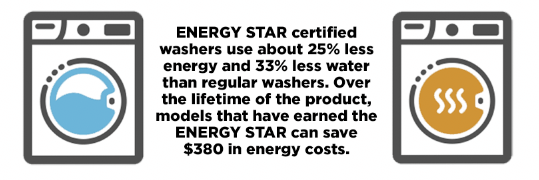 Use less energy
Use less energy
On average, a new ENERGY STAR certified clothes washer uses 316 kilowatts (kWh) of electricity and can save you about $35 a year on your utility bills compared to a standard model.
Use less water
A full-sized ENERGY STAR certified washer uses 14 gallons of water per load, compared to the 20 gallons used by a standard machine. That’s a savings of more than 2,000 gallons of water per year!
Fill it up
Washers use about the same amount of energy regardless of the size of the load, so run full loads whenever possible.
Wash in cold water
Water heating accounts for about 90% of the energy it takes to operate a washer. Unless you’re dealing with oily stains, washing in cold water will generally do a good job of cleaning. Switching your temperature setting from hot to warm can cut energy use in half. Using the cold cycle reduces energy use even more.
Use a drying rack or hang clothes outside
Where and when possible, air-drying clothes instead of using a dryer not only saves energy, but also helps them last longer.
Clean the lint filter
Cleaning the filter after every load will improve air circulation and increase the efficiency of the dryer. It’s also an important safety measure.
KITCHEN
The kitchen is a busy place in a home with lots of appliances, so there’s a big opportunity to save here.
Use the microwave instead of oven
Microwaves use up to 80% less energy than conventional ovens. In addition to the energy savings, microwaves typically cook food much faster and don’t generate as much heat in your kitchen.
Set the appropriate temperature
Keep your refrigerator at 35 to 38 degrees Fahrenheit.
Allow air circulation behind the fridge
Leave a few inches between the wall and the refrigerator, and keep the condenser coils clean if you have an older model. Read the user’s manual to learn how to safely clean coils. Coil cleaning brushes can be purchased at most hardware stores.
Check the door seals
Make sure the seals around the refrigerator door are airtight. If not, replace them. Be sure to keep the door closed to minimize the amount of time the refrigerator door is open. ENERGY STAR certified refrigerators use less energy and help us reduce our impact on the environment. If all refrigerators sold in the United States were ENERGY STAR certified, the energy cost savings would grow to nearly $700 million each year and 9 billion pounds of annual greenhouse gas emissions would be prevented, equivalent to the emissions from more than 870,000 vehicles.
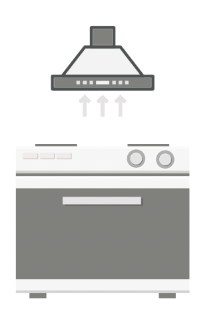
Install a range hood
An ENERGY STAR certified kitchen range hood helps control moisture and remove odors from cooking. Ventilation fans use 60% less energy on average than standard models, saving more than $60 in electricity costs over the life of the fan.
Use the right sized pot
A 6″ pot on an 8″ burner wastes over 40 percent of the burner’s heat. Also, cover pots and pans to keep heat in.
Grill out when you can
During summer months, cooking outdoors is a great way to save energy and eliminate unwanted heat from cooking indoors.
Save gallons of water
A new ENERGY STAR certified dishwasher will save, on average, 3,870 gallons of water over its lifetime.
Air dry
If your dishwasher has this option, use it whenever possible. Your dishwasher won’t generate heat and circulate air to dry your dishes.
Load it up
Dishwashers use about the same amount of energy and water regardless of the number of dishes inside, so run full loads whenever possible.
HEATING
As much as half of the energy used in your home goes to heating and cooling. So making smart decisions about your home’s heating, ventilating, and air conditioning (HVAC) system can have a big effect on your utility bills — and your comfort. Take these steps to increase the efficiency of your heating and cooling system.
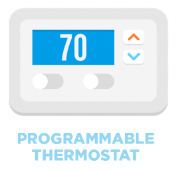 Programmable thermostat
Programmable thermostat
Through proper use of pre-programmed settings, a programmable thermostat can save you about $180 every year in energy costs.
- Set your thermostat lower in winter and higher in the summer months.
- Don’t run your heat or air conditioning when the windows are open.
- Consider putting on more layers before turning up the thermostat to maximize your energy savings.
- Open a window or use fans before turning down the thermostat in warmer months.
Change your HVAC system air filter
Check your air filter every month, especially during heavy use months. If the filter looks dirty, change it. At a minimum, change the filter every three months. A dirty filter slows down air flow and makes your system work harder to keep you comfortable.
Utilize the sun
For additional warmth, open drapes over windows that receive sunlight during the day. Closing them at night can reduce heat loss from a warm room up to 10%.
Properly seal windows and doors
Check for signs of air leakage around windows and doors. Then use caulk and weather-stripping to stop the leaks.
Air registers
Make sure that the connections at vents and registers are well-sealed where they meet the floors, walls, and ceiling. These are common locations to find leaks and disconnected ductwork. Also make sure that all vents are clear of any furniture or rugs to improve air flow and comfort.
COOLING
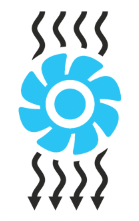
When buying new heating and cooling equipment such as a central air conditioning unit, proper sizing and quality installation are critical to your home’s energy efficiency and comfort. Remember, bigger doesn’t always mean better. Oversized equipment can cause reduced comfort and excessive noise. Oversizing also can shorten the life of the equipment by causing it to cycle on and off more frequently than a properly sized unit
If your HVAC equipment is more than 10 years old or not keeping your house comfortable, have it evaluated by a professional HVAC contractor. Depending on where you live, replacing your old heating and cooling equipment with ENERGY STAR qualified equipment can cut your annual energy bill by more than $115. But before you invest in a new HVAC system, make sure that you have addressed the big air leaks in your house and the duct system. Sometimes, these are the real sources of problems rather than your HVAC equipment.
Use your ceiling fan
Use a ceiling fan so you can turn down your air conditioner (A/C). This way you can lower your energy bill and still stay comfortable. Just be sure to turn it off when you leave the room. Ceiling fans cool people, not the room.
Get the right size air conditioner
Make sure your unit is not oversized. When installing, be sure the window unit fits tightly so outdoor air is not getting in.
Maintain your air conditioner
Replacing a dirty, clogged filter can reduce your air conditioner’s energy consumption by 5-15%. Remember to also check the evaporator coil, which should be cleaned annually for optimal efficiency.
Keep other electronics at a safe distance
Avoid placing items like lamps and televisions near your air conditioning thermostat. The thermostat senses heat from these appliances, which can cause the A/C to run longer than necessary.
WATER HEATER
Savings resulting from turning down your water heater temperature are based on two components: reduced standby losses (heat lost from water heater into surrounding basement area) and consumption (from water demand or use in your home). Set too high, or at 140 degrees Fahrenheit, your water heater can waste anywhere from $36 to $61 annually in standby heat losses and more than $400 in demand losses. Set at 120 degrees Fahrenheit, you will save energy and money. To help keep your hot water from cooling off before it gets to the tap, you can insulate the hot water piping for additional savings.
Increased insulation slows heat loss through the walls of the water heater. Even if your water heater is in a heated part of your home, energy loss through the walls of the water heater can be significant.
Insulate pipes
Insulate hot water pipes as well as the first 5-10 feet of cold water supply to the water heater.
Turn it off
Turn off electric water heaters when going away on vacation.
Save money
The average household spends more than $250 per year on water heating.
INSULATION
Vents, ducts, or electrical wires often have holes or gaps around them. This allows the air in your home to escape, increasing your energy bill and causing more drafts in your house. Seal small gaps with caulk and holes up to 3 inches in diameter with spray foam.
Why insulate?
Insulation slows down the movement of heat, keeping it where you want it. That means out in the hot summer months, and in during the chilly winter months.
- Greater comfort
- Lower utility bills
- Less noise
- Fewer drafts
- Less pollen and dust
- Prevention of ice dams
Water heater
If you have an electric water heater, wrap it in an insulating jacket. Increased insulation slows heat loss through the walls of the water heater. Even if your water heater is in a heated part of your home, energy loss through the walls of the water heater can be significant.
Seal air leaks with caulk
Applying caulk around windows, doors, electrical wiring and plumbing can save energy and money. There are many different types of caulking compounds available, but the most popular choice is silicone. Silicone caulk is waterproof, flexible and won’t shrink or crack.
Weather strip exterior doors
When choosing weather stripping materials, make sure it can withstand temperature changes, friction and the general “wear and tear” for the location of the door. Keep in mind, you will need separate materials for the door sweep (at the bottom of the door) and the top and sides.
SMARTHUB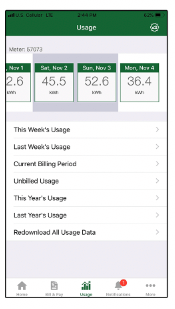
SmartHub is our online portal for members to access their account(s). Visit our website and log in, or create an account if you don’t have one yet. Not only will you be able to track your usage and compare to previous months’ usage, SmartHub offers many other features. This includes billing information, staying up-to-date with co-op news and signing up to receive notifications.
Did you know?
You can view your daily usage on SmartHub! As you can see, energy usage is much higher on the weekend compared to the following Monday. There are multiple ways you can see your usage. Whether you want to compare your usage to last year at this time, see how much usage you have accrued so far in this billing period, or check how much energy was used today, SmartHub is there to help. Download the mobile app in the App Store or Google Play Store. Click here to learn more about SmartHub.
QUESTION: I think the reason my bills are high is because my meter isn’t accurate. Is my meter broken or showing inaccurate information?
ANSWER: Many think that the problem is with our meters, but that is hardly ever the case. The meter’s job is to track usage. If you see usage spike, ask yourself a few questions:
- What was I doing on that day?
- Did I have visitors?
- Did I forget to turn something off?
- What was the weather like?
- Were my heating or cooling units running more than usual?
CALCULATE YOUR USAGE
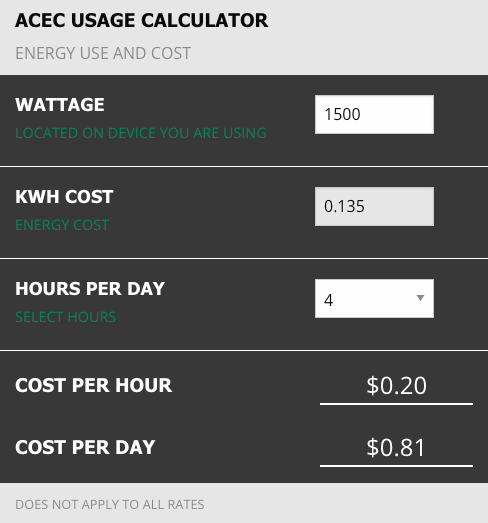 In order to determine how much an appliance may cost you during a 30 day billing period, use the following formula: Watts x Hours Used x Number of Days in a Billing Period / 1000
In order to determine how much an appliance may cost you during a 30 day billing period, use the following formula: Watts x Hours Used x Number of Days in a Billing Period / 1000
This will give you the kilowatt-hours (kWh), which is the measurement we use for billing. Then take you kWh times your billing rate and that will tell you how much it will cost you for the billing period.
Example
A 1,320 watt space heater runs for 10 hours a day during a 30 day billing period.
1,320 x 10 x 30 = 396,000 / 1000 = 396 kWh
396 kWh x $0.12 (Average Residential Rate) = $47.52 to run a spacer heater for the month.
Don’t like math? Let us do the work for you!
Click here to use our energy usage calculator. Find the wattage information on your device/appliance, select how many hours per day it is used, and we will calculate the rest based on the current residential rate.
Wattage
Below is a table of average wattages on typical household items. This will give you an idea of how much energy is being consumed in your home. The cost is based on the average residential rate of $0.12 in a 30 day billing period, using the formula on the previous page.
|
Appliance |
Wattage |
Hours Used Per Day |
Cost Per Month |
| Cable Box | 140 | 8 | $4.54 |
| Ceiling Fan | 35 | 8 | $1.13 |
| Coffee Maker | 1000 | 1 | $4.05 |
| Computer – Desktop PC | 75 | 4 | $1.25 |
| Computer – Notebook PC | 25 | 4 | $0.41 |
| Deep Fryer | 1000 | 2 | $8.10 |
| Desktop Computer Monitor | 42 | 4 | $0.68 |
| Dishwasher | 330 | 4 | $5.35 |
| Dryer | 2790 | 4 | $45.20 |
| DVD/VCR | 17 | 4 | $0.28 |
| Electric Blanket | 400 | 8 | $12.96 |
| Electronic Air Cleaner/Filter | 50 | 8 | $1.62 |
| Furnace Fan | 295 | 8 | $9.56 |
| Garage Door Opener | 400 | 2 | $3.24 |
| Hair Dryer | 1800 | 1 | $7.29 |
| Humidifier | 11 | 4 | $0.18 |
| Iron | 1100 | 1 | $4.46 |
| Lawn Sprinkler | 11 | 2 | $0.09 |
| Microwave Oven | 1500 | 1 | $6.08 |
| Pool Pump | 1000 | 2 | $8.10 |
| Printer – Inkjet | 13 | 1 | $0.05 |
| Printer – Laser | 250 | 1 | $1.01 |
| Receiver | 28 | 8 | $0.91 |
| Rechargeable Power Tool | 13 | 1 | $0.05 |
| Refrigerator | 225 | 24 | $21.87 |
| Router/DSL/Cable Modem | 6 | 24 | $0.58 |
| Slow Cooker | 200 | 8 | $6.48 |
| Space Heater | 1500 | 8 | $43.20 |
| Stereo System | 33 | 4 | $0.53 |
| TV – ED/HD, <40″ | 150 | 4 | $2.43 |
| TV – ED/HD, >40″ | 234 | 4 | $3.79 |
| TV – LCD | 150 | 4 | $2.43 |
| TV – Plasma | 300 | 4 | $4.86 |
| Toaster | 1100 | 1 | $4.46 |
| Toaster Oven | 1051 | 1 | $4.26 |
| Vacuum | 542 | 1 | $2.20 |
| Video Game System | 36 | 4 | $0.58 |
| Washer | 255 | 4 | $4.13 |
| Water Heater | 4500 | 2 | $36.45 |
| Well Pump | 725 | 2 | $5.87 |
Energy Assistance
In order to assist in meeting energy costs, the federal government has developed the Energy Assistance Program. To find out if you qualify, or to apply, contact your county Department of Health and Social Services. Apply early to establish your eligibility and receive full benefits.
Click here for a listing of local energy assistance agencies.
Focus On Energy
Focus on Energy partners with Adams-Columbia Electric Cooperative to deliver real, measurable energy and financial savings for Wisconsin’s residents and businesses. To learn about available incentives and rebates available for your home or business, visit www.focusonenergy.com/acec.
Sources of information:
- Focus On Energy
- U.S. Department of Energy
- U.S. Energy Information Administration, 2015 Residential Energy Consumption Survey
- U.S. Environmental Protection Agency, ENERGY STAR program



